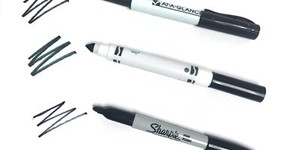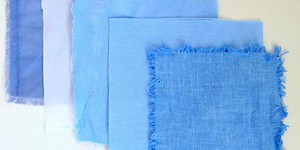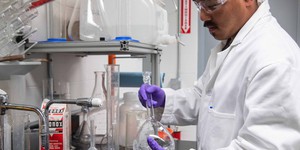Summary
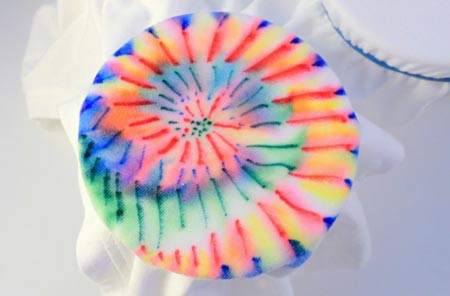
Introduction
Have you ever made a tie-dyed t-shirt? It can be a lot of fun to dye a shirt in bright colors with spiraling designs (especially when it is done on a warm day outside to prevent indoor messes)! In this science activity, you will get to dye a t-shirt with your own colorful artwork using permanent markers. Along the way, you will find out how solubility helps your drawings leave beautiful designs on the fabric.Materials
- Rubber bands (at least 2)
- Plastic cups (at least 2)
- Colorful assortment of permanent markers
- Water
- 70% isopropyl alcohol, also called rubbing alcohol
- Medicine dropper
- White t-shirt that can be dyed
- Optional: Newspapers. These are to protect your work surface.
- Optional: Hair dryer
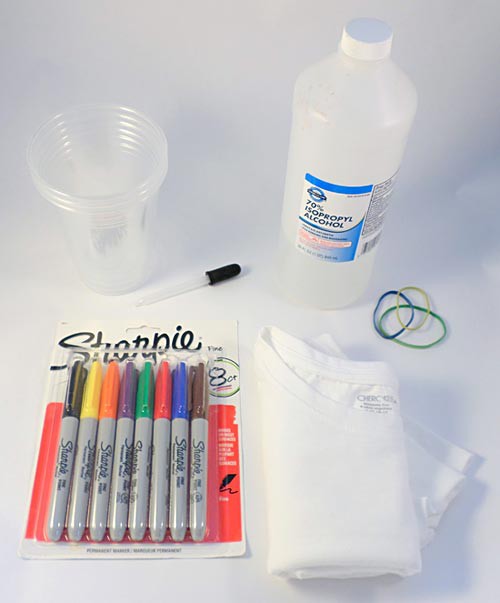 Image Credit: Teisha Rowland, Science Buddies / Science Buddies
Image Credit: Teisha Rowland, Science Buddies / Science Buddies
Prep Work
- If you want to protect the surface you will be dyeing your t-shirt on, cover it with a few layers of newspaper sheets. Note that permanent markers can stain fabric and other materials, so be careful when using them.
Instructions
- Lay out the t-shirt on the surface you will be dyeing it on.
- Wherever you want to make a design on the t-shirt, place a plastic cup underneath the t-shirt (below both the front and back sides), and then loop a rubber band around the edge of the cup, going from the front of the t-shirt. This should end up making a flat, tight circle of t-shirt fabric be stretched over the opening of the cup. Do this to at least two places on the t-shirt so that you have at least two flat circles to draw in.
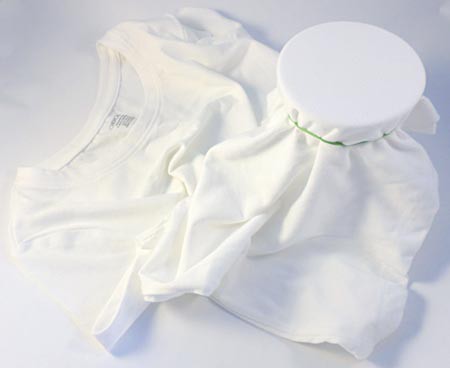 Image Credit: Teisha Rowland, Science Buddies / Science Buddies
Image Credit: Teisha Rowland, Science Buddies / Science Buddies
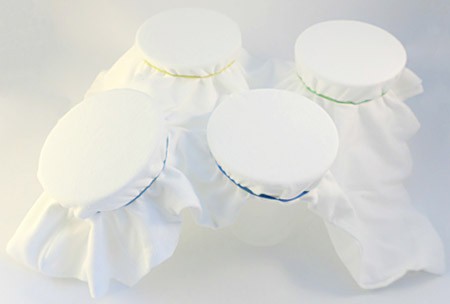 Image Credit: Teisha Rowland, Science Buddies / Science Buddies
Image Credit: Teisha Rowland, Science Buddies / Science Buddies
- Use the permanent markers to draw some colorful designs in each flat t-shirt circle that you made with the cups. Fill in at least two flat circles with your drawings.
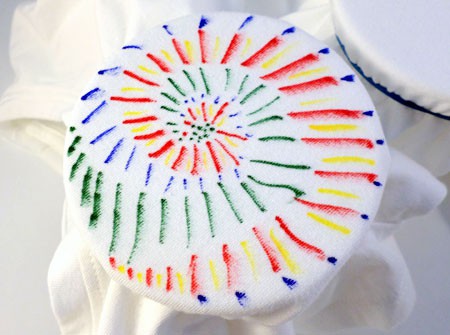 Image Credit: Teisha Rowland, Science Buddies / Science Buddies
Image Credit: Teisha Rowland, Science Buddies / Science Buddies
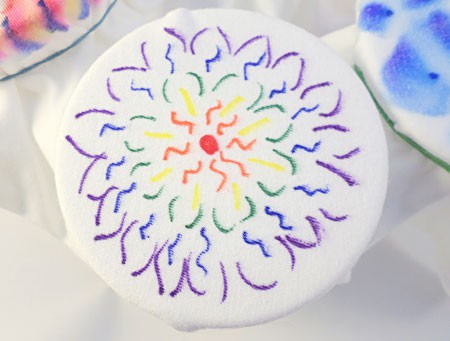 Image Credit: Teisha Rowland, Science Buddies / Science Buddies
Image Credit: Teisha Rowland, Science Buddies / Science Buddies
- Use the medicine dropper to drop a few drops of water onto the center of one of the flat circles that you drew in.What happens to the permanent marker ink when the water touches it?
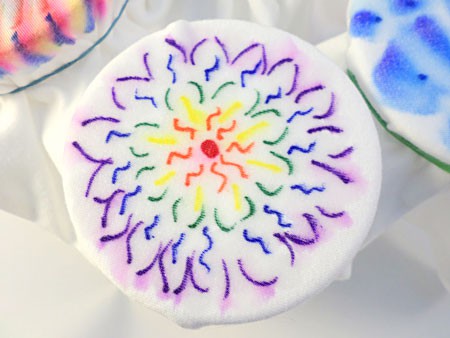 Image Credit: Teisha Rowland, Science Buddies / Science Buddies
Image Credit: Teisha Rowland, Science Buddies / Science Buddies
- Drop several more drops of water onto the same flat circle until it is all damp. Does the permanent marker ink change as the piece of fabric becomes all damp?
- Now use the medicine dropper to drop a few drops of isopropyl alcohol onto the center of one of the other flat circles that you drew in.What happens to the permanent marker ink when the isopropyl alcohol touches it?
- Drop several more drops of isopropyl alcohol onto the same flat circle until it is all damp. Does the permanent marker ink change as the piece of fabric becomes all damp with isopropyl alcohol?
- Compare the two flat circles.Which one looks better? Why?
- Tip: If you want to make one of the flat circles look better, try letting it dry (you can let it dry naturally or use a hairdryer) and then adding drops of the other liquid (water or isopropyl alcohol), which should be the one that gave you the best results.
- If you want to make more colorful designs on your t-shirt, let the first ones dry and then repeat the procedure on different parts of the t-shirt where you want some artwork, but this time just use the liquid (water or isopropyl alcohol) that gave you the best results!
What Happened?
You should have seen that when water was added to the drawing, the ink stayed in place, whereas when the isopropyl alcohol was added, the ink ran and spread out, creating colorful artwork. The ink used in permanent markers does not dissolve in water, meaning the ink is insoluble in water. This is why when you added drops of water to the designs you made on the t-shirt, the ink should have pretty much stayed in place. However, permanent marker ink does dissolve in isopropyl alcohol, meaning the ink is soluble in isopropyl alcohol. Because of this, when you added drops of isopropyl alcohol to the designs on the t-shirt, the ink should have spread out and ran along the fabric with the isopropyl alcohol. (This is similar to what happens when a drop of water lands on a piece of paper with something printed on it, and the ink starts to run on the paper.) If you let the design dry that you put drops of water on, putting drops of isopropyl alcohol on it should make the ink run and create another colorful design on your t-shirt!
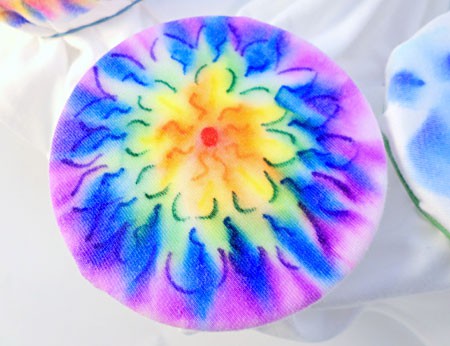 Image Credit: Teisha Rowland, Science Buddies / Science Buddies
Image Credit: Teisha Rowland, Science Buddies / Science Buddies
Digging Deeper
You have probably noticed what happens when a drop of water lands on a piece of paper with words or a picture printed on it — the ink starts to run. The drop of water is absorbed into the paper and then flows through it. As the water moves, it carries the ink particles along with it. Why does the water move the ink? This is because of solubility — the ink is soluble in the water. Solubility is an important property of matter. If a chemical is soluble in water, then the chemical will dissolve, or disappear, when it is added to water. This is why the ink can dissolve in the drop of water on the paper and then travel along with the water through the paper.
If a chemical is not soluble, or insoluble, then it will not dissolve. Can you think of some things that are insoluble in water? If a piece of paper were printed with ink that was insoluble in water, what would happen when a drop of water fell on it? The ink should remain in place on the paper, as it would not be carried away by the water flowing through the paper.
Ask an Expert
For Further Exploration
- To more closely compare results between using water vs. using isopropyl alcohol, make a symmetrical design in one of the flat t-shirt circles and treat the top half with water and the bottom half with isopropyl alcohol. How exactly does the top half of the circle look compared to the bottom half?
- If you wash the t-shirt made in this activity, you will probably find that the colors fade. Can you figure out a way to keep the designs from fading?
- Some markers are made using multiple pigments, and you can see these pigments using a chemistry technique called chromatography. Check out the links in the "Resources" section to find out more about chromatography. Can you separate different pigments that are in permanent markers using chromatography?

